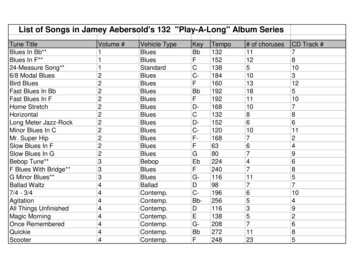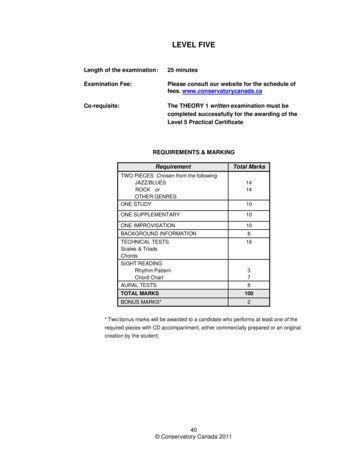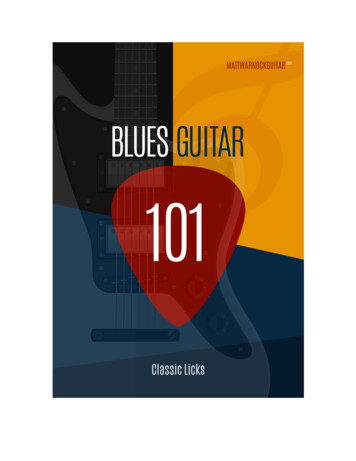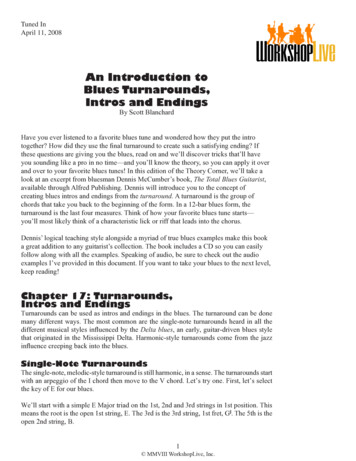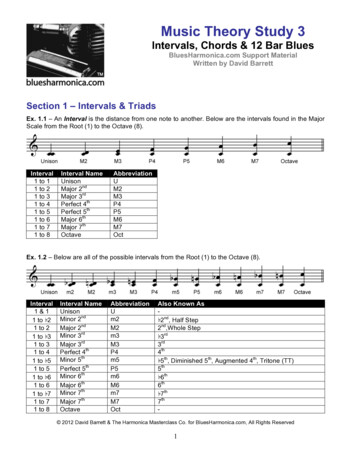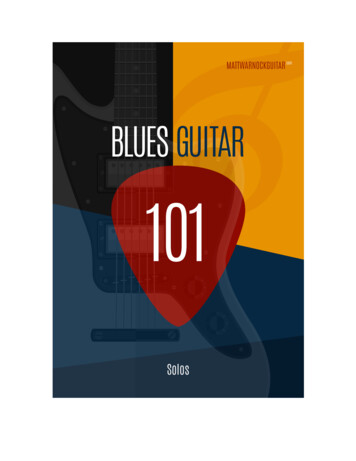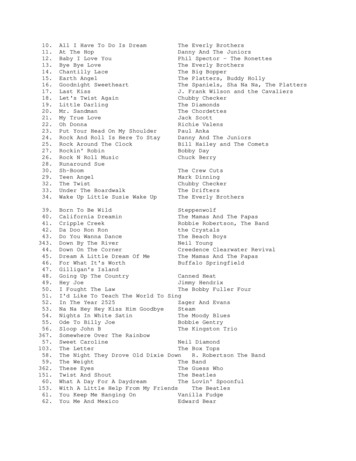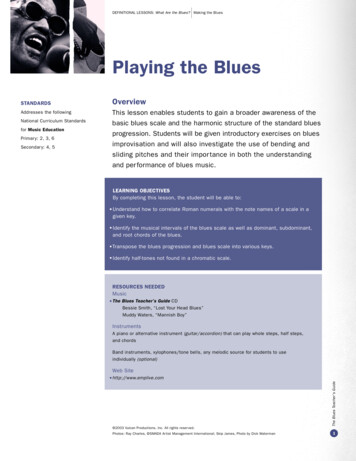
Transcription
DEFINITIONAL LESSONS: What Are the Blues? Making the BluesPlaying the BluesAddresses the followingNational Curriculum Standardsfor Music EducationPrimar y: 2, 3, 6Secondar y: 4, 5OverviewThis lesson enables students to gain a broader awareness of thebasic blues scale and the harmonic structure of the standard bluesprogression. Students will be given introductory exercises on bluesimprovisation and will also investigate the use of bending andsliding pitches and their impor tance in both the understandingand per formance of blues music.LEARNING OBJECTIVESBy completing this lesson, the student will be able to:Understand how to correlate Roman numerals with the note names of a scale in agiven key.Identify the musical inter vals of the blues scale as well as dominant, subdominant,and root chords of the blues.Transpose the blues progression and blues scale into various keys.Identify half-tones not found in a chromatic scale.RESOURCES NEEDEDMusicThe Blues Teacher’s Guide CDBessie Smith, “Lost Your Head Blues”Muddy Waters, “Mannish Boy”InstrumentsA piano or alternative instrument (guitar/accordion) that can play whole steps, half steps,and chordsBand instruments, xylophones/tone bells, any melodic source for students to useindividually (optional)Web Sitehttp://www.emplive.com 2003 Vulcan Productions, Inc. All rights reser ved.Photos: Ray Charles, SMADA Ar tist Management International; Skip James, Photo by Dick WatermanThe Blues Teacher’s GuideSTANDARDS1
DEFINITIONAL LESSONS: What Are the Blues? Making the BluesVIEWING GUIDEFILM TIE-INSVisit www.pbs.org/thebluesDefining the BluesRed, White and Blues (end of the “Was the UK Blues Scene Significant?” segment, in whicha variety of people define the blues)for index of film segmentstar t times and lengths.Introductory ExerciseThe blues has often been por trayed as slow, mournful music full of bleak images of personalpain and despair. This exercise asks students to expand their understanding of the genre.Star t by asking students what feelings they associate with the word “blue.” After discussing,ask what they imagine blues music might be about. Why do they have these notions? Howmuch of their description has to do with the way the music sounds? With the music’s lyrics?With their understanding of the word “blue” in the context of feelings?Play Bessie Smith’s “Lost Your Head Blues.” Ask students if this song reinforces orchallenges their notions of blues music. Point out that while the song might sound mournful,it actually depicts a bold woman willing to stand up to her husband. Next, play Muddy Waters’“Mannish Boy.” What does this song do to students’ preconceptions of blues music? Finally,play an example of “jump blues.” (See the glossar y, p.44, for a definition.) By this point,student definitions of blues music should be more nuanced than they were originally. Pointout that the blues is a means of self-expression; as such, it naturally includes a wide varietyof emotional moods, including sadness, desperation, humor, flir tation, and, ver y often,happiness. Conclude this discussion by playing the end of the “Was the UK Blues SceneSignificant?” segment from Red, White and Blues, in which a variety of people talk about whatdefines the blues. [See Film Tie-Ins for detailed film information. Shor t song clips by jumpblues per formers such as Louis Jordan and Wynonie Harris can be found in Experience MusicProject’s Digital Collection at http://www.emplive.com.]After students have explored the music that exists under the umbrella of the blues, informthem that cer tain musical elements are present in much blues music. To allow them to hearthe commonalities in blues songs, play a variety of tracks and ask students to identify theseshared characteristics. To reinforce student understanding of essential blues elements,assign them to read the essay in this guide, “Understanding the 12-Bar Blues.”This entire exercise can be wrapped up by having students complete a one-page writtenresponse to the question “What are the blues?” Student writings should capture the ideaspresented in the lesson.Focus ExerciseThe Blues Teacher’s Guide Playing the Blues2This exercise introduces the blues scale and blues improvisation. The theory of using numbersthat correlate to the seven letters identifying note names in music should be introducedif students are not familiar with the construction of an eight-tone diatonic scale (i.e., beginwith C 1, D 2, E 3, and continue up to the octave C 8). Play the scale a number of timesto allow students to hear the pattern. Next, introduce the notes of the chromatic scale byinserting them between the eight-tone scale. Again, the teacher should demonstrate by playinga chromatic scale. If students have their own instruments, they should be encouraged to playboth scales as well. To fur ther reinforce student understanding, ask them to sing the scalesand at the same time mirror the inter vals with hand movements.Inform students that the blues scale uses some of the same pitches as the eight-tone majorscale while adding some others. The blues scale is built around a pentatonic scale, which iscommon in many African music cultures. Begin to introduce this blues scale by demonstratingthe notion of bending pitches. Do so by playing the flat 3rd, flat 5th, and flat 7th steps inany given key. Now, incorporate all the pitches that construct a blues scale in any given key.
DEFINITIONAL LESSONS: What Are the Blues? Making the BluesAnother characteristic of the blues is improvisation. Inform students that theblues scale is used to construct melody, which is created through variationson the order in which the blues scale pitches are played. The flexible order andduration of the chosen pitches is called musical improvisation. Improvisationallows per formers to create a different mood or convey a different meaningthrough their personal choices of notes, tempos, and rhythms.Walk students through the following exercise, with the goal of using thenotes from the blues scale to make up their own phrases (of 12 measuresin 4/4 time) on any melodic instrument. Star t by having students echoshor t phrases you play on non-pitched instruments. Once students havemastered the echo, keep playing the same rhythmic phrase while one ortwo individual students improvise their own rhythm. Continue this call-andresponse exercise until all class members have had a chance to improvise.Maintain this call-and-response format, using longer and longer phrasesand eventually transitioning into pitched instruments and two-three notes.Once students have mastered diatonic improvisation, move into bluesimprovisation, using the blues scale and the same technique of echo andcall and response.To help build student competence in blues improvisation and to reinforcethe conversational tone of improvising, wrap up by allowing students to tr y“trading fours” with a partner. Trading fours refers to each player in the duotaking turns improvising on four-bar measures.In addition to the blues scale and the melodies related to it, the use ofa par ticular harmonic or chord pattern identifies the blues. This exerciseintroduces students to the three basic chords of the blues. These chordscreate the ver tical harmony that suppor ts the horizontal melodies. Star tby presenting a visual example of the music staff, with a root chord (I),subdominant chord (IV), and the dominant chord (V)—the most commonchords used in a blues progression. Demonstrate playing these chordsin the key of C and have students echo. Then, have students constructthese chords in one or two easier keys by changing the identity of the rootchord. Inform students that one of the more popular formulas for a bluesprogression is played using the chords mentioned above in the followingpattern: I–IV–I–I–IV–IV–I–I–V–IV–I–V. Students should be encouraged to playthe progression above on chorded instruments, or at least the root noteof each chord in the progression if they do not have a chorded instrument.Conclude by introducing the notion of a 7th chord. Show what such a chordlooks like on a music staff, using a V7—common to the blues—for yourexample. Play the V7 and give students a chance to do the same. Finally,have students play the pattern above, substituting the V7 for the V. Discusshow adding the 7th chord changes the sound and how this sound can beheard in the blues.RESEARCH AND ANALYSISAssign students to prepare a compare/contrastpresentation by listening to a Delta bluesrecording that uses bended pitches and thenper forming a stripped-down version of the samesong without using the bended-pitch technique.In conjunction with their per formances, studentsshould compose a shor t writing in which theydescribe how the song’s mood or feeling changeswhen the bended pitches are eliminated. Possibleoptions for songs include “Cross Road Blues” byRober t Johnson, “Stack O’ Lee” by MississippiJohn Hur t, and “Trouble So Hard.”SYNTHESIS AND ASSESSMENTChoose a blues song that was not used in thelesson. Assign students to analyze the song,presenting their analysis either orally or in writing.Student analysis should include the following:identification of the root of each chord used in theharmonic progression and any melodic pitchesused that are not in the standard blues scale;instances of the use of bended pitch and oftrading fours (four measures vocal/four measuresinstrument); the use of call and response betweenthe singer and his/her own instrument; and acritique of how well the sound of the musicmatches the content of the lyrics.The Blues Teacher’s Guide Playing the BluesShow, via overhead projector or handout, the notes in a blues scale: the root(1), the flat 3rd (b3), the 4th (4), the flat 5th (b5), the 5th (5), the flat 7th(b7), and the octave (8). Choosing a specific key, have students repeat thisscale pattern up and down on whatever chromatic instruments are available.Periodically, students should rever t to playing the original eight-tone majorscale to train their ear to hear the difference between the two types of scales.327
DEFINITIONAL LESSONS: What are the Blues? Making the BluesExtensionsADDITIONAL EXERCISES1. The Focus Exercise prepared students to combine the ver tical, horizontal, and improvisational elements ofplaying the blues. Begin by having half the students play the root notes or chords of the basic blues progressionin 4/4 time, repeating back to the beginning of the progression without dropping a beat. The other half of theclass should use the notes of the blues scale to improvise a 12-bar melody that will correspond with the harmonicprogression. To assist the students playing the melody, recommend the following formula: play each note of theblues scale as a quar ter note. When you reach the top of the scale (8), rest for a beat and then come back down inquar ter notes, again resting for one beat before beginning upward again. Three complete scale cycles up and downwill be equal to one entire chorus of 12-bar blues or one time through the harmonic progression. [This will not betrue improvisation until the students gradually begin to change the order in which they play the notes of the bluesscale and trade the quar ter-note rhythm for more varied and individual choices.]2. Discuss the role that body language plays in song deliver y. How does a per former’s physical commitment toa song impact its message? How would students expect someone who is singing about love to look? How aboutletting loose on Saturday night? Have students listen to several blues songs, and then ask how they would expectthe per formers to look while singing and playing.Instruct students that during slaver y and in the subsequent Jim Crow South, oppression meant that, in addition tobeing denied many freedoms, African Americans were expected to make their bodies look subser vient in posture.Blacks, when interacting with whites in the Jim Crow South, were expected to have their shoulders slumped over,with their faces looking down. Looking a white person in the eye was considered disrespectful.Using historic footage from The Blues films (clips from any of the films will work), have students cite examplesof per formers who demonstrate subser vient posture while per forming. Students should note the content of theirsong lyrics as well. In contrast, ask students to cite examples where the per formers are both direct and confidentin their presentation, again also noting the content of their song lyrics. After viewing the films, discuss whetherthe song lyrics matched the posture. This exercise can be extended by asking students to research the state ofrace relations in the countr y at the time of each per formance identified in the films. Conclude by asking studentsto create a visual that depicts the physical posture, lyrics, and accompanying racial climate of three or fourper formances.RESEARCH AND ANALYSISThere are many variations beyond the basic blues progression presented in the Focus Exercise. Have studentsresearch other acceptable standard progressions and transcribe them. Once at least five progressions have beentranscribed, students should play them to hear how they sound. When familiar with the sound of each, assignstudents to find a blues song that employs each. Selecting these examples should also help students uncoverhow cer tain progressions are employed by blues musicians from different regions or time periods. Followingtheir research, ask students to make presentations in which they demonstrate a few progressions, cite examples(and play a recording of them, if possible), and discuss when and where these progressions were commonlyemployed. Students can star t their research at ons/BluesProgressions.pdf but should look beyond this site for additional examples.The Blues Teacher’s Guide Playing the Blues4SYNTHESIS AND ASSESSMENTWithin the 12-bar blues format, students should write an original blues song, using a key employed in previousactivities. Direct students to begin by mapping out the chords in each measure (e.g., I–I–IV–I), using the standardblues scale and standard harmonic progression covered earlier in the lesson. Students should next write melodicpitches in the staff above the chords. The use of bended pitch should be encouraged and can be notated by asmall “scoop” line either extending upward toward the melodic note or downward from it, depending on the desiredsound. Students should have the option of going beyond writing the song down in manuscript by recording theirper formance on video or cassette tape. If students are not proficient enough in per formance, the teacher shouldplay the compositions (melody and harmony separately, if necessar y). Lyrics do not need to be a component of thisexercise, although an accelerated student may be encouraged to experiment on his/her own.
DEFINITIONAL LESSONS: What are the Blues? Making the BluesSUPPLEMENTARY RESOURCESReadingsBrooks, Lonnie. Blues for Dummies. Foster City, CA: IDG Books Worldwide, 1998.Jahn, Janheinz. “Blues: The Conflict of Cultures.” Write Me a Few of Your Lines: A Blues Reader.Tracy, Stephen C., ed. Amherst: University of Massachusetts Press, 1999.Web SitesAlvira, José Rodríguez. Online Music Theor y Reference: Chords. http://www.teoria.com/reference/chords.htm.The Blues Teacher’s Guide Playing the BluesScales: The Blues Scale. Cyber fretBass.com. http://www.cyber fretbass.com/scales/blues/index.php.5
The blues scale is built around a pentatonic scale, which is common in many African music cultures. Begin to introduce this blues scale by demonstrating the notion of bending pitches. Do so by playing the flat 3rd, flat 5th, and flat 7th steps in any given key. Now, incorporate all the pitches that construct a blues scale in any given key.File Size: 2MB
